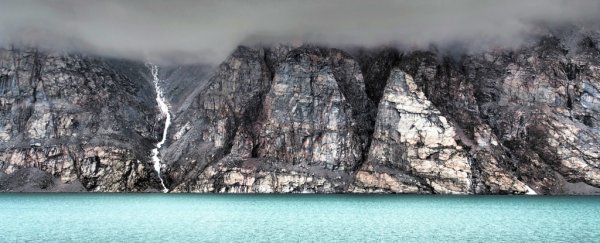Scientists have uncovered a splintered remnant of Earth's continental crust from millions of years ago, embedded in the isolated wilderness of northern Canada.
Baffin Island, located in between the Canadian mainland and Greenland, is a vast Arctic expanse covering over 500,000 square kilometres (almost 200,000 square miles), making it the fifth largest island in the world.
While the island comprises part of the newest recognised territory in Canada – Nunavut, formally established in 1999 – a new discovery shows this ancient landmass has undisclosed ties that stretch backwards in time so far, they actually emanate from a distant geologic eon.
While analysing igneous rock samples recovered from diamond exploration drilling in the Chidliak Kimberlite Province at the southern stretches of Baffin Island, researchers identified a mineral signature in the rock they had never expected to find.
"Kimberlites are subterranean rockets that pick up passengers on their way to the surface," explains geologist Maya Kopylova from the University of British Columbia.
"The passengers are solid chunks of wall rocks that carry a wealth of details on conditions far beneath the surface of our planet over time."
In this case, those passengers had completed a very long journey. The team says kimberlite rocks like this, formed at depths below 150 kilometres (93 miles), are driven to the surface by both geological and chemical forces.
In terms of the geological component, their emergence underneath modern-day Baffin Island represents the end of a colossal dispersal that occurred approximately 150 million years ago, during rifting of the continental plate of the North Atlantic Craton (NAC).
This NAC refers to chunks of lithospheric rock that date back billions of years ago to the Archean Eon, representing some of the best exposures of Earth's earliest continental crust.
Rifted into fragments millions of years ago, NAC has been exposed in Scotland, Labrador, and Greenland, but researchers weren't expecting to find it in Baffin Island's Hall Peninsula.
"The mineral composition of other portions of the North Atlantic Craton is so unique there was no mistaking it," says Kopylova.
"It was easy to tie the pieces together. Adjacent ancient cratons in Northern Canada – in Northern Quebec, Northern Ontario and in Nunavut – have completely different mineralogies."
To reach their findings, the team used a number of analytical techniques – including petrography, mineralogy, and thermobarometry – to study 120 rock samples, called xenoliths, taken from the kimberlite province.
The results showed the Chidliak mantle "strikingly resembles" the NAC rocks from West Greenland in terms of their bulk composition and mineral chemistry, while showing numerous contrasts with markers from other cratons.
"We conclude that the Chidliak mantle demonstrates an affinity with only one adjacent block of cratonic mantle, the NAC," the authors explain in their paper.
"We interpret this similarity as indicating the former structural coherence of the cratonic lithosphere of the Hall Peninsula Block and the NAC craton prior to subsequent rifting into separate continental fragments."
The new findings mean we've discovered about 10 percent more of the known expanse of the NAC – a pretty sizeable chunk of this incredibly ancient crust. And thanks to newer mantle modelling techniques, we can also envisage the shape of some of Earth's earliest known rock formations at much greater depths than ever before.
"With these samples we're able to reconstruct the shapes of ancient continents based on deeper, mantle rocks," says Kopylova.
"We can now understand and map not only the uppermost skinny layer of Earth that makes up one percent of the planet's volume, but our knowledge is literally and symbolically deeper."
The findings are reported in Journal of Petrology.
